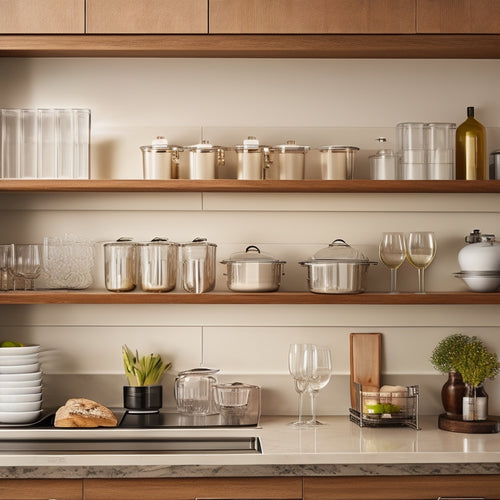
Transform Your Kitchen Into Allergy-Safe Haven
Share
Transforming your kitchen into an allergy-safe haven requires a multifaceted approach. Start by implementing strategic organizational systems, providing safe food and snacking options, and raising awareness about food allergies through education and community outreach. It's also essential to manage cross-contamination risks by separating allergy-safe zones, designating prep areas, and ensuring easy cleaning and sanitizing. By establishing clear guidelines and protocols, you can empower individuals with food allergies to take control of their health. With these measures in place, you can create a safe and supportive environment, and reveal the secrets to a truly allergy-friendly kitchen.
Key Takeaways
• Implement strategic organizational systems, such as labeling and storage solutions, to ensure safe food and minimize cross-contamination risks.
• Designate a specific area for safe foods in the pantry and create snack boxes with safe options for each family member.
• Establish clear guidelines and protocols for safe food handling, preparation, and storage to prevent accidental exposure.
• Guarantee kitchen safety by separating allergy-safe zones from allergen areas and implementing designated prep areas for allergy-safe meal prep.
• Empower individuals with food allergies to take control of their health by educating them on safe food handling practices and providing resources for managing food allergies.
Organizing for Allergy Safety
By implementing a few strategic organizational systems, you can effectively transform your kitchen into an allergy-safe haven, where risk of accidental exposure is reduced to a large extent.
A well-planned labeling system and thoughtful storage solutions can help keep allergens at bay. A key aspect of pantry organization is designating a specific area for safe foods only, ensuring easy accessibility and minimizing the risk of cross-contamination.
Additionally, creating snack boxes with safe options can provide quick access to allergy-friendly choices. By streamlining your kitchen's organization, you can create a safe and stress-free environment for your family.
Safe Food and Snacking Options
Incorporating safe food and snacking options into your daily routine is essential for maintaining an allergy-friendly environment. With a little creativity, you can provide your family with a variety of healthy and enjoyable choices.
Snack box solutions and portable snacks are ideal for quick access and on-the-go convenience. Consider setting up individualized snack boxes for each family member, stocked with safe and nutritious options. This approach not only promotes safe snacking but also enables emergency preparedness.
In the event of an unexpected situation, having a stash of safe snacks readily available can be a lifesaver. By prioritizing safe food and snacking options, you can create a haven of comfort and security for your loved ones.
Allergy Education and Awareness
Raising awareness about food allergies is crucial for creating a safe and supportive environment. It starts with educating family members, caregivers, and educators on the importance of allergen avoidance and emergency preparedness.
Integrating food allergy education into school curriculum can help promote understanding and empathy among peers. Community outreach programs play a significant role in raising awareness and providing resources for families managing food allergies.
Managing Cross-Contamination Risks
How do you guarantee that your kitchen remains a safe haven from cross-contamination risks, where even the slightest mistake can have devastating consequences for individuals with food allergies?
Effective cross-contamination prevention begins with a thoughtful kitchen layout, separating allergy-safe zones from areas where common allergens are present.
Implementing individualized cooking utensils and designated prep areas for allergy-safe meal prep reduces the risk of cross-contamination.
A well-organized kitchen layout also enables easy cleaning and sanitizing, further minimizing the risk of accidental exposure.
Building Confidence in Safety
By establishing clear guidelines and protocols for safe food handling and preparation, individuals with food allergies can feel empowered to take control of their health and well-being. Building confidence in safety is vital in creating an allergy-safe haven in the kitchen.
This can be achieved by implementing safety protocols, such as designating an allergy-friendly cabinet and using individualized cooking utensils. Confidence building is also fostered through education and awareness, ensuring that family members and caregivers understand the importance of safe food handling practices.
Frequently Asked Questions
Can I Still Host Dinner Parties With an Allergy-Friendly Kitchen?
When hosting dinner parties, consider guests' dietary restrictions by incorporating allergy-friendly recipes and implementing hosting tips for allergies, such as labeling dishes and providing ingredient lists, to guarantee a safe and inclusive environment.
How Do I Handle Food Allergy Bullying in Schools?
To address food allergy bullying in schools, implement parent education programs, advocate for inclusive school policies, and promote empathy and understanding among students, teachers, and staff to create a safe and supportive environment.
Are There Any Allergy-Friendly Kitchen Renovation Grants Available?
"Can we truly prioritize food safety without considering the financial burden of kitchen renovations? Fortunately, funding options exist, such as government assistance programs, to support kitchen upgrades, providing renovation support for a safer, allergy-friendly environment."
Can I Use Essential Oils to Clean Allergy-Friendly Surfaces?
When considering essential oils for surface cleaning, guarantee they are allergy-safe and non-toxic to maintain a safe kitchen environment. Research essential oil benefits and opt for gentle, fragrance-free alternatives that prioritize health and safety.
How Do I Explain Food Allergies to My Toddler?
Did you know that 1 in 13 children under 18 has a food allergy? When explaining food allergies to your toddler, use simple and relatable language, emphasizing the importance of avoiding specific foods and introducing allergy-friendly snacks during mealtime.
Related Posts
-

Over-The-Door Kitchen Towel Holder
An over-the-door kitchen towel holder is a smart way to maximize your space while keeping towels easy to grab. It hoo...
-

Space-Saving Kitchen Solutions for Busy Homeowners
To maximize your kitchen's potential, start with vertical storage solutions like wall-mounted shelves and pegboards f...
-

Pull-Out Cabinet Shelves for Dish Drainer Storage
Pull-out cabinet shelves are a revolutionary innovation for your dish drainer storage. They maximize vertical space a...


